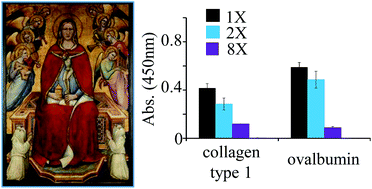Development and application of an ELISA method for the analysis of protein-based binding media of artworks
Abstract
ELISA has been used extensively in scientific research and medical diagnostics since its invention in the 1960s. The application of ELISA to identify proteinaceous materials used in works from cultural heritage is a recent development and presents an important area of further investigation. This study introduces an optimized ELISA with a horse radish peroxidase (HRP) reporting system to identify select proteins in the adhesives and binders used in artworks. The described methodology is successfully applied to samples obtained from three different artworks from the Metropolitan Museum of Art. Furthermore, these experiments use protein quantitation to study the impact of specific pigments/binder combinations on the antigen detection by commercial antibodies. Our results suggest that the aging of specific pigment/binder combinations could impact the ELISA detection of proteins in artworks.


 Please wait while we load your content...
Please wait while we load your content...